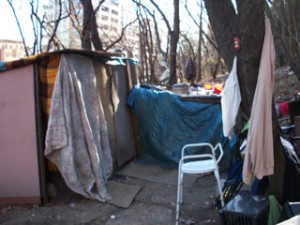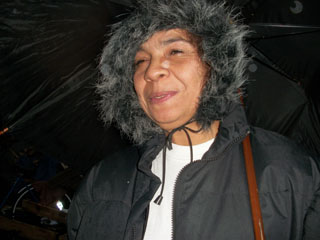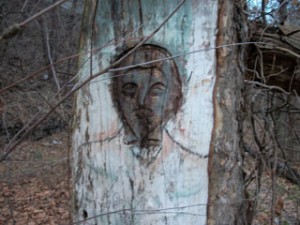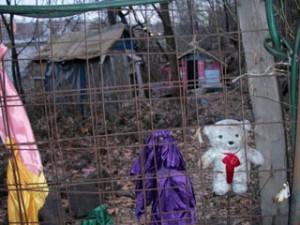The homes along the coastline and cliffs of Hudson County offer some of the most striking views of Manhattan.
Carmen Maysonet, 48, won her slice of the skyline the hard way. She became homeless for the first time a year ago, and she now resides among a hidden community of cliff dwellers on land bordering Jersey City, Union City and Hoboken.
Maysonet lives in a 4-foot-high shack made of wood, tarp and blankets, large enough for a bed and a small night table. There is a calendar on one wall, a morning prayer posted on another. Votive candles are lit all around the room — that’s the trick, she says, for keeping warm on cold December days.
The Palisades, as locals call it, has existed since the ’80s. It is home to as many as 60 people, mostly transient. Fifteen people reside there permanently, according to April Kuzas, vice president of the Washington Park Association and chairwoman of the organization’s homeless committee.
Few people in the region have forged such personal relationships with the Palisade community as Kuzas, who makes weekly treks down the cliff, bearing food, clothes and even appointment dates to social services. This type of bond is the secret to successful outreach, she said — especially at the Palisades. She has come to learn the intricate social infrastructure, as well as the diverse categories of homelessness, that exists here. Many residents are chronically homeless and resist housing resources, but not all. Kuzas feels that, stoked by economic collapse, not only has the Palisades become a symbol of the county’s current crisis in affordable housing, but it represents one of the most unique homeless outreach conundrums. The Palisades is the best housing options for some of its residents.
Maysonet defies traditional profiles of the Palisades population. On one hand, she is actively seeking housing.
“I’m just hoping someone will help me get out of here,” Maysonet said. “I don’t have anywhere else to go. If I knew where else to go to get help, believe me, I would have went.”
But in the meantime, Maysonet resists shelters. Part of the reason is personal; part is practical. She’s been to shelters before and found the experience harrowing.
“I’ve had bad experience in shelters,” she said. “(Some) people, they kind of (use) abusive language talk, and they push you around, they take your things. I didn’t like it at all.”
Also, some of the shelters in Hudson County, such as Hoboken and PERC Shelter, require residents to leave early in the morning. But in the bitter winter months, hitting the streets at that hour is not just a comfort issue, Maysonet said, but also a medical issue. She suffers from a chronic infection, for which she receives regular medical treatment.
“They get you up at 7 in the morning,” said Maysonet. “Where am I going to go at 7 in the morning, unless you’re working?”
Maysonet is working. She is a part-time cleaning lady and earns $50 to $60 per week. But in the current economy, she has difficulty finding enough hours. Employment prospects are only aggravated by a nagging back injury and side effects of her medication.
“I get all sorts of medication,” she said. “Sometimes I’ll be up (on the street) and I get dizzy and I have to come back (down) here.”
As she sees it, if she slept overnight at a shelter, she would only have to return back to the Palisades in the morning. So why leave in the first place, she wonders.
Maysonet is stuck between a rock — the economy — and a hard place — the affordable housing crisis in Hudson County. She never bothered applying for Section 8 housing subsidies because she knows the deal: There is currently a 10-year waiting list, and that waiting list is closed.
“I ain’t got no where to go, and rents are high,” said Maysonet. “I wish I had Section 8. It takes too long. By the time I get Section 8, I’ll be an old lady.”
She can’t even afford a single-room occupancy, which averages about $125 dollars per week. She knows that if she splits the cost of single room, as many of her neighbors have before, that a roommate might not come through, and she’d get beat for the total rent.
Hudson County’s affordable housing agenda is “very active,” according to Susan Mearns, who, in her 21 years in the field, has overseen 3,000 units of affordable housing. They have also released a 10-year plan to end homelessness. The wish list includes 650 units, specifically for the chronically homeless; 178 for a sub-population of the homeless; and 400 for homeless families. The county also helped fund a $1 million 8-unit permanent housing project, designed for the chronically homeless, which broke ground earlier this month.
But county government often encounters challenges in achieving its active agenda. New Jersey is a home-rule state, meaning municipalities are self-governing, Mearns adds. The county can only offer incentives through tax abatements, zoning or board of adjustment ordinances, and by providing resolutions needed to apply for state funds.
And not all elected officials in the region feel the need for more affordable housing. Councilman Michael Lenz of Hoboken’s 3rd ward feels there is already enough and building more will not alleviate homelessness.
“It’s not unlike parking. People say you can solve the parking problem in Hoboken by building more garages,” Lenz said. “But to the degree that you build more garages, more people bring cars into town. Homelessness is not a local problem.”
Suzanne Byrne, executive director at the York Street Project, could not disagree more.
“Homeless can be addressed locally,” Byrne said. “(It can be done) simply by passing local ordinances.”
Byrne was referring specifically to inclusionary zoning ordinances — which currently are in place in Bayonne and Weehawken, but not in Jersey City, Hoboken or Union City — that require a percentage of all new development to be affordable.
Still, Mearns admits that for some people, particularly those living at the Palisades, affordable housing may not be affordable enough.
“We prioritize all of our projects to those earning 50 percent of area median income — that’s the county’s public policy,” said Mearns. “Is there a population that is lower than 50 percent of area median income? Absolutely.”
Additionally, some of the restrictions that come with using federal money can further complicate housing for people such as the residents of the Palisades community.
“When you are dealing with federal dollars, in order to place them in an appropriate unit for their earnings, they need to document their earnings for you,” Mearns said. “Typically, an undocumented population or intermittent working population, like those living in the Palisades, is best served at the shelters.”
But Maysonet’s world does not converge at the shelter.
Part of the enclave’s charm is its secrecy to the world above. The land is heavily wooded and fenced in by cement retaining walls and metal gates. The descent is treacherously steep. But those who brave the climb and, more importantly, can wrangle passed gatekeepers who protect against intruders — visits are by invitation only — an almost magical world emerges. Tiny homes, some two stories high, some painted bright pinks and blues, are built in the side of the cliff. The trees are adorned with ornaments; art is carved into the barks of the wood.
But what keeps people in the Palisades, more than just its exclusivity, is the rich social network it offers to its inhabitants.
Maysonet’s feelings about the Palisade are very complex. In the same breath she longs to leave, but she has undoubtedly grown sentimental about her life here. She feels like a mother to her community, she said. Just outside in front of her shanty door sits a makeshift kitchen, fueled by firewood, replete with boilerplates and adorned with a vase of fresh flowers. Each night she feeds four other people.
“I make quick stuff, chop meat, rice for everybody — it’s too cold to be cooking out there,” Maysonet said. “I like cooking. When I have my own place, I can do all kinds of meals for myself.”
In return, the others perform chores, like fetching water for drinking and cooking, and gathering wood for fire. One of the men is also her means of protection. He serves as gatekeeper, keeping away unwanted visitors and volatile drug addicts who convene a ways up the hill. Unfortunately, much of the drug activity that takes place at the Palisades happens within a small segment of the population that has come to misrepresent its other residents, Maysonet said.
In response to growing community opposition, Hudson County Police Chief John Bartucci appeared at a Washington Park Association meeting to address the situation. Homelessness, it seems, isn’t a local problem, until the homeless become a problem to the locals. Some were concerned about the drug use, others about the fires Palisades residents build to stay warm. The result was a county-sponsored “clean-up” that removed many of the homes along the cliff.
“We didn’t want to create any problems,” Bartucci said. “Rather than have law enforcement people in uniforms speak to these people, Tom Harrigan went and spoke to the people living there.”
Tom Harrigan, director of the nearby PERC Shelter, has developed close relationships with the Palisade residents, like Kuzas. He feeds many of them nightly at his shelter’s soup kitchen. He said the clean-up was “very tactful.”
“Carol Ann Wilson (Hudson County director of Health and Human Services) made sure that all of these people were treated well, that none were abused or mistreated,” said Harrigan. “But many of the people living there refuse shelter. They resist a lot of the restrictions.”
Kuzas, however, has mix feelings about the benefits of clean-ups.
“When you’re making choices like that for the community — people do pay taxes and have a voice — they have a right for that removal,” Kuzas said.
She is mindful of the potential safety risk the homeless can pose to the surrounding neighborhood. But she sees little use in the county-sponsored yearly clean-up, as residents usually return shortly after. She also feels the locals misunderstand the unique outreach the Palisades requires. It has to be a more patient, circumstance-based kind of outreach, she said.
“It’s been a long, slow process to get them appointments, to get them resources, to get them social service, to get them Medicaid,” Kuzas said.
There are also plans to rebuild the 14th Street viaduct over the next three years, and construction will begin next year, according Jersey City Heights Councilman Bill Gaughan, Also, there are plans by Hoboken to create an public park beneath the viaduct. Gaughan said that the homeless community should not be displaced by the construction efforts. But Kuzas fears that once the land becomes a public space, more community members, who don’t understand the complex needs of the Palisade population, will become alarmed. The announcement of the construction project, for her, is the starting gun in a race to secure housing for people such as Maysonet. But in the midst of crises in housing and the economy, it is an uphill battle far steeper than the Palisades cliff themselves.
“(Local elected officials] can help. They can help more. They really can look in the subject,” Maysonet said. “There’s a lot of us out here that really want an apartment and change (in) lifestyle. There’s a lot of them that don’t. What can I say?”






Comments
Good article – this encampment reminds me of a hooverville in the 80s at the manhattan side of the Manhattan Bridge. The residents lived in shanties, one had built a teepee. They cadged electricty from the nearby electric pole… Ms. Maysonet is a resilent person and a heartbreaking but realistic reflection of the hard times we are going through. I would like to see a follow-up on this enclave – maybe after the winter comes and goes.
That Manhattan Bridge shanty town was eventually bulldozed.
kewl stuff
I see a great improvement in your writing, I’d love to get in touch. Keep up the great work! Your writing is very inspiration.
Good to discover that there are blog owners that care about their blogs and not release all kind of inutile stuff but rather try to maintain it clean and priceless for the interest of their readers. You’ve done a good job and i thank you for that and also for not shocking me with useless garbage and spam.Thank You
Excellent read, I just passed this onto a colleague who was doing a little research on that. And he actually bought me lunch because I found it for him smile So let me rephrase that: Thanks for lunch!
Hi. I treasured to drop you a quick note to impart my thanks. I’ve been following your blog for a month or so and have plucked up a heap of effective information as well as relished the way you’ve structured your site. I am attempting to run my own blog however I think its too general and I would like to focus more on smaller topics.
Wow! what an idea ! What a concept ! Beautiful .. Amazing
I wanted to praise you for this good post!! I unquestionably liked each little bit of it. I have bookmarked your site to
You definitely nailed that one on the head!
That was brilliant.
Just blowing some time on Stumbleupon and I found your entry. Not normally what I like to learn about, but it was definitely worth my time. Thanks.
thumbs up! i linked to this post
I as a rule don’t post in Blogs. On the other hand, your blog forced me to! Impressive work.. Keep it coming! Thanks!
Thanks for taking the time to discuss this, I feel strongly about it and love learning more on this topic. If possible, as you gain expertise, would you mind updating your blog with extra information? It is extremely helpful for me.
I must say that by and large I am really pleased with this website.After reading your post I can tell you are well informed about your writing. Looking forward to future posts.Cheers!
Your site is great. I m gonna read all, thank you.
I thought it was going to be some boring old post, but it really compensated for my time. I will post a link to this page on my blog. I am sure my visitors will find that very useful.
I was just browsing for related blog posts for my project research and I happened to discover yours. Thanks for the excellent information!
just happen to be google searching ,trying to find the write words to describe what these shacks could be called. Kudos,for observing and respecting the homeless while bringing light to something I have thought about for years. I am 23, grew up in Hoboken and the heights. These shacks have been around since I was a child. Before the area around the tracks that lead up there were fenced in, My sister and I would climb those hills. At one point in the early 94 a man on those hills had farm animals. roosters,chickens and i heard a goat one time. regardless of the age of this article, i have to state that while today the construction of these huts are crude ,it shows a will to live that makes my heart ache a little. hey with the way this world is going, i might just go build one myself and enjoy the manhattan skyline for free!!hahah